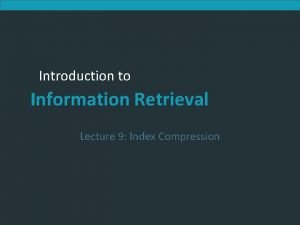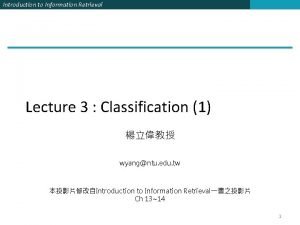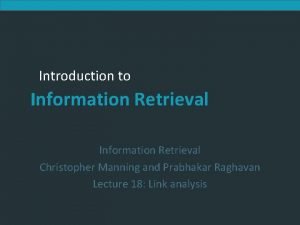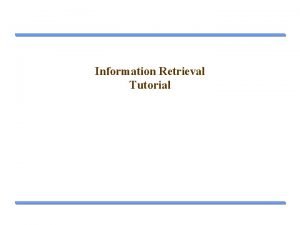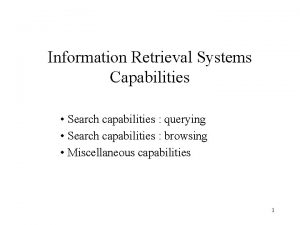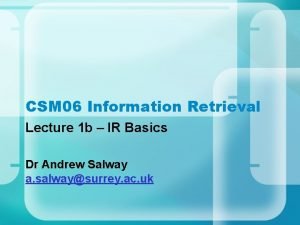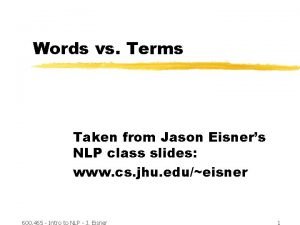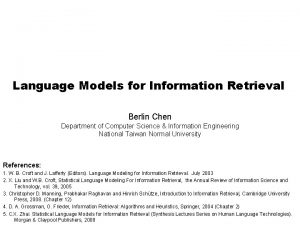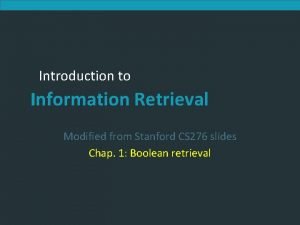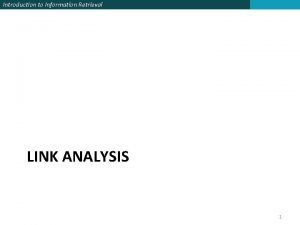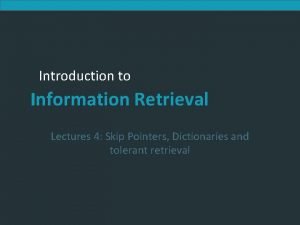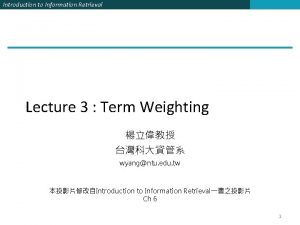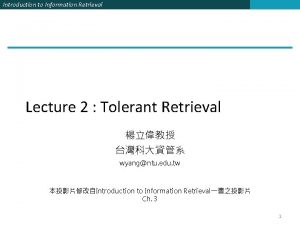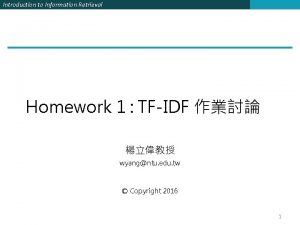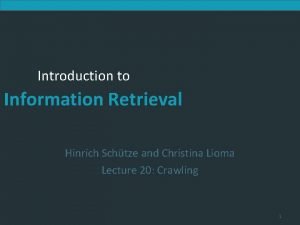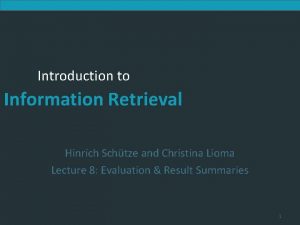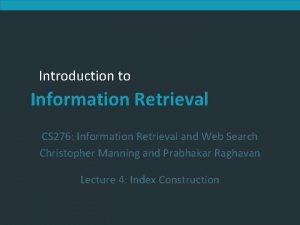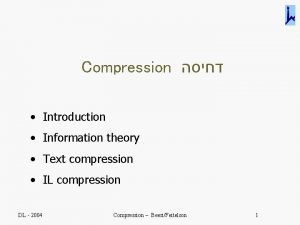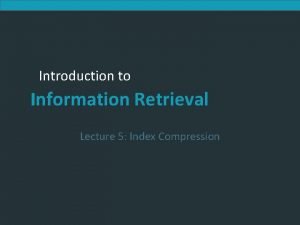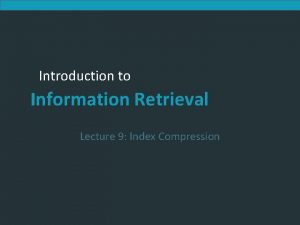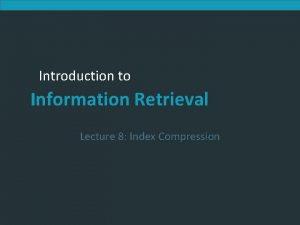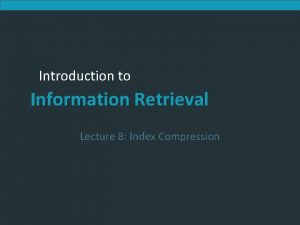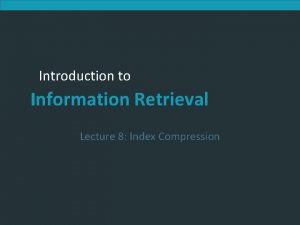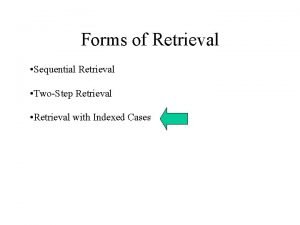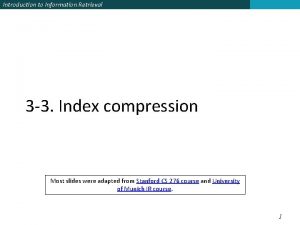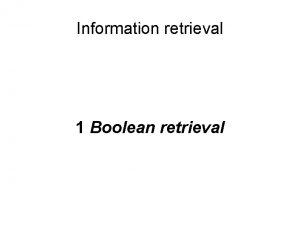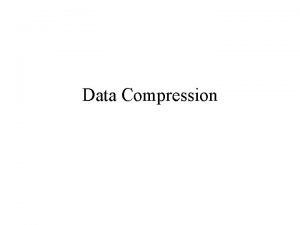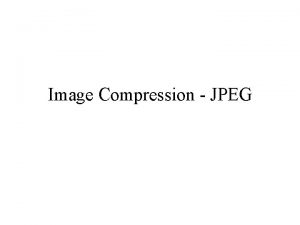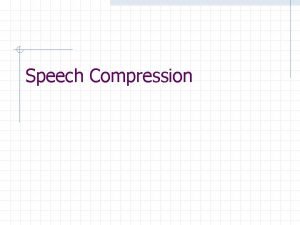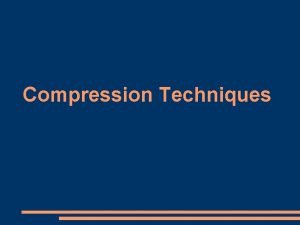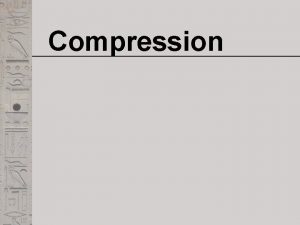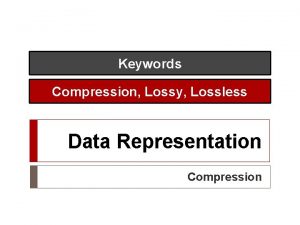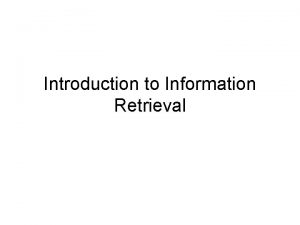Introduction to Information Retrieval Lecture 9 Index Compression













































- Slides: 45

Introduction to Information Retrieval Lecture 9: Index Compression

Introduction to Information Retrieval Ch. 5 Index Compression § Collection statistics in more detail (with RCV 1) § How big will the dictionary and postings be? § Dictionary compression § Postings compression 2

Introduction to Information Retrieval Ch. 5 Why compression (in general)? § Use less disk space § Saves a little money § Keep more stuff in memory § Increases speed § Increase speed of data transfer from disk to memory § [read compressed data | decompress] is faster than [read uncompressed data] § Premise: Decompression algorithms are fast § True of the decompression algorithms we use 3

Introduction to Information Retrieval Ch. 5 Why compression for inverted indexes? § Dictionary § Make it small enough to keep in main memory § Make it so small that you can keep some postings lists in main memory too § Postings file(s) § Reduce disk space needed § Decrease time needed to read postings lists from disk § Large search engines keep a significant part of the postings in memory. § Compression lets you keep more in memory § We will devise various IR-specific compression schemes 4

Sec. 5. 1 Introduction to Information Retrieval Recall Reuters RCV 1 § § § symbol N L M statistic documents avg. # tokens per doc terms (= word types) avg. # bytes per token value 800, 000 200 ~400, 000 6 (incl. spaces/punct. ) § avg. # bytes per token 4. 5 (without spaces/punct. ) § § avg. # bytes per term 7. 5 non-positional postings 100, 000 5

Sec. 5. 1 Introduction to Information Retrieval Index parameters vs. what we index (details IIR Table 5. 1, p. 80) size of word types (terms) non-positional postings dictionary non-positional index Size (K) ∆% cumul % ∆ % cumul Size (K) % 109, 971 ∆ % cumul % Unfiltered 484 197, 879 No numbers 474 -2 -2 100, 680 -8 -8 179, 158 -9 -9 Case folding 392 -17 -19 96, 969 -3 -12 179, 158 0 -9 30 stopwords 391 -0 -19 83, 390 -14 -24 121, 858 -31 -38 150 stopwords 391 -0 -19 67, 002 -30 -39 94, 517 -47 -52 stemming 322 -17 -33 63, 812 -42 94, 517 -52 -4 0 Exercise: give intuitions for all the ‘ 0’ entries. Why do some zero entries correspond to big deltas in other columns? 6

Introduction to Information Retrieval Sec. 5. 1 Lossless vs. lossy compression § Lossless compression: All information is preserved. § What we mostly do in IR. § Lossy compression: Discard some information § Several of the preprocessing steps can be viewed as lossy compression: case folding, stop words, stemming, number elimination. 7

Introduction to Information Retrieval Sec. 5. 1 Vocabulary vs. collection size § How big is the term vocabulary? § That is, how many distinct words are there? § Can we assume an upper bound? § In practice, the vocabulary will keep growing with the collection size 8

Introduction to Information Retrieval Sec. 5. 1 Vocabulary vs. collection size § Heaps’ law: M = k. Tb § M is the size of the vocabulary, T is the number of tokens in the collection § Typical values: 30 ≤ k ≤ 100 and b ≈ 0. 5 § In a log-log plot of vocabulary size M vs. T, Heaps’ law predicts a line with slope about ½ § It is the simplest possible relationship between the two in log-log space § An empirical finding (“empirical law”) 9

Sec. 5. 1 Introduction to Information Retrieval Heaps’ Law Fig 5. 1 p 81 For RCV 1, the dashed line log 10 M = 0. 49 log 10 T + 1. 64 is the best least squares fit. Thus, M = 101. 64 T 0. 49 so k = 101. 64 ≈ 44 and b = 0. 49. Good empirical fit for Reuters RCV 1 ! For first 1, 000, 020 tokens, law predicts 38, 323 terms; actually, 38, 365 terms 10

Introduction to Information Retrieval Sec. 5. 1 Exercises § What is the effect of including spelling errors, vs. automatically correcting spelling errors on Heaps’ law? § Compute the vocabulary size M for this scenario: § Looking at a collection of web pages, you find that there are 3000 different terms in the first 10, 000 tokens and 30, 000 different terms in the first 1, 000 tokens. § Assume a search engine indexes a total of 20, 000, 000 (2 × 1010) pages, containing 200 tokens on average § What is the size of the vocabulary of the indexed collection as predicted by Heaps’ law? 11

Introduction to Information Retrieval Heap’s Law suggests that § The dictionary continues to increase with more documents in the collection, rather than a maximum vocabulary size being reached § The size of the dictionary is quite large for large collections 12

Introduction to Information Retrieval Sec. 5. 1 Zipf’s law § Heaps’ law gives the vocabulary size in collections. § We also study the relative frequencies of terms. § In natural language, there a few very frequent terms and very many very rare terms. § Zipf’s law: The ith most frequent term has frequency proportional to 1/i. § cfi ∝ 1/i = K/i where K is a normalizing constant § cfi is collection frequency: the number of occurrences of the term ti in the collection. 13

Introduction to Information Retrieval Sec. 5. 1 Zipf consequences § If the most frequent term (the) occurs cf 1 times § then the second most frequent term (of) occurs cf 1/2 times § the third most frequent term (and) occurs cf 1/3 times … § Equivalent: cfi = K/i where K is a normalizing factor, so § log cfi = log K - log i § Linear relationship between log cfi and log i § Another power law relationship 14

Introduction to Information Retrieval Sec. 5. 1 Zipf’s law for Reuters RCV 1 15

Introduction to Information Retrieval Ch. 5 Compression § Now, we will consider compressing the space for the dictionary and postings § Basic Boolean index only § No study of positional indexes, etc. § We will consider compression schemes 16

Introduction to Information Retrieval Sec. 5. 2 DICTIONARY COMPRESSION 17

Introduction to Information Retrieval Sec. 5. 2 Why compress the dictionary? § Search begins with the dictionary § We want to keep it in memory § Memory footprint competition with other applications § Embedded/mobile devices may have very little memory § Even if the dictionary isn’t in memory, we want it to be small for a fast search startup time § So, compressing the dictionary is important 18

Sec. 5. 2 Introduction to Information Retrieval Dictionary storage - first cut § Array of fixed-width entries § ~400, 000 terms; 28 bytes/term = 11. 2 MB. Dictionary search structure 20 bytes 4 bytes each 19

Introduction to Information Retrieval Sec. 5. 2 Fixed-width terms are wasteful § Most of the bytes in the Term column are wasted – we allot 20 bytes even for 1 letter terms. § And we still can’t handle supercalifragilisticexpialidocious or hydrochlorofluorocarbons. § Written English averages ~4. 5 characters/word. § Exercise: Why is/isn’t this the number to use for estimating the dictionary size? § Ave. dictionary word in English: ~8 characters § How do we use ~8 characters per dictionary term? § Short words dominate token counts but not type average. 20

Sec. 5. 2 Introduction to Information Retrieval Compressing the term list: Dictionary-as-a-String Store dictionary as a (long) string of characters: n Pointer to next word shows end of current word n. Hope to save up to 60% of dictionary space. …. systilesyzygeticsyzygialsyzygyszaibelyiteszczecinszomo…. n Total string length = 400 K x 8 B = 3. 2 MB Pointers resolve 3. 2 M positions: log 23. 2 M = 22 bits = 3 bytes 21

Introduction to Information Retrieval Sec. 5. 2 Space for dictionary as a string § § § 4 bytes per term for Freq. Now avg. 11 4 bytes per term for pointer to Postings. bytes/term, not 20. 3 bytes per term pointer Avg. 8 bytes per term in term string 400 K terms x 19 7. 6 MB (against 11. 2 MB for fixed width) 22

Sec. 5. 2 Introduction to Information Retrieval Blocking § Store pointers to every kth term string. § Example below: k=4. § Need to store term lengths (1 extra byte) …. 7 systile 9 syzygetic 8 syzygial 6 syzygy 11 szaibelyite 8 szczecin 9 szomo…. Save 9 bytes on 3 pointers. Lose 4 bytes on term lengths. 23

Introduction to Information Retrieval Sec. 5. 2 Net § Example for block size k = 4 § Where we used 3 bytes/pointer without blocking § 3 x 4 = 12 bytes, now we use 3 + 4 = 7 bytes. Saved another ~0. 5 MB. This reduces the size of the dictionary from 7. 6 MB to 7. 1 MB. We can save more with larger k. Why not go with larger k? 24

Introduction to Information Retrieval Sec. 5. 2 Exercise § Estimate the space usage (and savings compared to 7. 6 MB) with blocking, for block sizes of k = 4, 8 and 16. 25

Introduction to Information Retrieval Sec. 5. 2 Dictionary search without blocking § Assuming each dictionary term equally likely in query (not really so in practice!), average number of comparisons = (1+2∙ 2+4∙ 3+4)/8 ~2. 6 Exercise: what if the frequencies of query terms were non-uniform but known, how would you structure the dictionary search tree? 26

Introduction to Information Retrieval Sec. 5. 2 Dictionary search with blocking § Binary search down to 4 -term block; § Then linear search through terms in block. § Blocks of 4 (binary tree), avg. = (1+2∙ 2+2∙ 3+2∙ 4+5)/8 = 3 compares 27

Introduction to Information Retrieval Sec. 5. 2 Exercise § Estimate the impact on search performance (and slowdown compared to k=1) with blocking, for block sizes of k = 4, 8 and 16. 28

Sec. 5. 2 Introduction to Information Retrieval Front coding § Front-coding: § Sorted words commonly have long common prefix – store differences only § (for last k-1 in a block of k) 8 automata 8 automate 9 automatic 10 automation 8 automat*a 1 e 2 ic 3 ion Encodes automat Extra length beyond automat. Begins to resemble general string compression. 29

Introduction to Information Retrieval Sec. 5. 2 RCV 1 dictionary compression summary Technique Fixed width Size in MB 11. 2 Dictionary-as-String with pointers to every term 7. 6 Also, blocking k = 4 7. 1 Also, Blocking + front coding 5. 9 30

Introduction to Information Retrieval Sec. 5. 3 POSTINGS COMPRESSION 31

Introduction to Information Retrieval Sec. 5. 3 Postings compression § The postings file is much larger than the dictionary, factor of at least 10. § Key desideratum: store each posting compactly. § A posting for our purposes is a doc. ID. § For Reuters (800, 000 documents), we would use 32 bits per doc. ID when using 4 -byte integers. § Alternatively, we can use log 2 800, 000 ≈ 20 bits per doc. ID. § Our goal: use far fewer than 20 bits per doc. ID. 32

Introduction to Information Retrieval Sec. 5. 3 Postings: two conflicting forces § A term like arachnocentric occurs in maybe one doc out of a million – we would like to store this posting using log 2 1 M ~ 20 bits. § A term like the occurs in virtually every doc, so 20 bits/posting is too expensive. 33

Introduction to Information Retrieval Sec. 5. 3 Postings file entry § We store the list of docs containing a term in increasing order of doc. ID. § computer: 33, 47, 154, 159, 202 … § Consequence: it suffices to store gaps. § 33, 14, 107, 5, 43 … § Hope: most gaps can be encoded/stored with far fewer than 20 bits. 34

Introduction to Information Retrieval Sec. 5. 3 Three postings entries 35

Introduction to Information Retrieval Sec. 5. 3 Variable length encoding § Aim: § For arachnocentric, we will use ~20 bits/gap entry. § For the, we will use ~1 bit/gap entry. § If the average gap for a term is G, we want to use ~log 2 G bits/gap entry. § Key challenge: encode every integer (gap) with about as few bits as needed for that integer. § This requires a variable length encoding § Variable length codes achieve this by using short codes for small numbers 36

Introduction to Information Retrieval Sec. 5. 3 Variable Byte (VB) codes § For a gap value G, we want to use close to the fewest bytes needed to hold log 2 G bits § Begin with one byte to store G and dedicate 1 bit in it to be a continuation bit c § If G ≤ 127, binary-encode it in the 7 available bits and set c =1 § Else encode G’s lower-order 7 bits and then use additional bytes to encode the higher order bits using the same algorithm § At the end set the continuation bit of the last byte to 1 (c =1) – and for the other bytes c = 0. 37

Sec. 5. 3 Introduction to Information Retrieval Example doc. IDs 824 gaps VB code 00000110 10111000 829 215406 5 214577 10000101 00001100 10110001 Postings stored as the byte concatenation 000001101011100001010000110010110001 Key property: VB-encoded postings are uniquely prefix-decodable. For a small gap (5), VB uses a whole byte. 38

Introduction to Information Retrieval Sec. 5. 3 Other variable unit codes § Instead of bytes, we can also use a different “unit of alignment”: 32 bits (words), 16 bits, 4 bits (nibbles). § Variable byte alignment wastes space if you have many small gaps – nibbles do better in such cases. § Variable byte codes: § Used by many commercial/research systems § Good low-tech blend of variable-length coding and sensitivity to computer memory alignment matches (vs. bit -level codes, which we look at next). 39

Introduction to Information Retrieval Unary code § Represent n as n 1 s with a final 0. § Unary code for 3 is 1110. § Unary code for 40 is 111111111111111111110. § Unary code for 80 is: 11111111111111111111110 § This doesn’t look promising, but…. 40

Introduction to Information Retrieval Sec. 5. 3 Gamma codes § We can compress better with bit-level codes § The Gamma code is the best known of these. § Represent a gap G as a pair length and offset § offset is G in binary, with the leading bit cut off § For example 13 → 1101 → 101 § length is the length of offset § For 13 (offset 101), this is 3. § We encode length with unary code: 1110. § Gamma code of 13 is the concatenation of length and offset: 1110101 41

Sec. 5. 3 Introduction to Information Retrieval Gamma code examples number length g-code offset 0 none 1 0 0 2 10 0 10, 0 3 10 1 10, 1 4 110 00 110, 00 9 1110 001 1110, 001 13 1110 101 1110, 101 24 11110 1000 11110, 1000 511 11110 111111110, 1111 1025 111110 000001 111110, 000001 42

Introduction to Information Retrieval Sec. 5. 3 Gamma code properties § G is encoded using 2 log G + 1 bits § Length of offset is log G bits § Length of length is log G + 1 bits § All gamma codes have an odd number of bits § Almost within a factor of 2 of best possible, log 2 G § Gamma code is uniquely prefix-decodable, like VB § Gamma code can be used for any distribution § Gamma code is parameter-free 43

Introduction to Information Retrieval Sec. 5. 3 RCV 1 compression Data structure dictionary, fixed-width Size in MB 11. 2 dictionary, term pointers into string 7. 6 with blocking, k = 4 7. 1 with blocking & front coding 5. 9 collection (text, xml markup etc) collection (text) Term-doc incidence matrix 3, 600. 0 960. 0 40, 000. 0 postings, uncompressed (32 -bit words) 400. 0 postings, uncompressed (20 bits) 250. 0 postings, variable byte encoded 116. 0 postings, g-encoded 101. 0 44

Introduction to Information Retrieval Sec. 5. 3 Index compression summary § We can now create an index for highly efficient Boolean retrieval that is very space efficient § Only 4% of the total size of the collection § Only 10 -15% of the total size of the text in the collection § However, we’ve ignored positional information § Hence, space savings are less for indexes used in practice § But techniques substantially the same. 45
 Index compression in information retrieval
Index compression in information retrieval Index construction in information retrieval
Index construction in information retrieval Bsbi vs spimi
Bsbi vs spimi Skip pointer information retrieval
Skip pointer information retrieval Introduction to information retrieval
Introduction to information retrieval Bvf document
Bvf document Introduction to information retrieval
Introduction to information retrieval Introduction to information retrieval manning
Introduction to information retrieval manning 01:640:244 lecture notes - lecture 15: plat, idah, farad
01:640:244 lecture notes - lecture 15: plat, idah, farad Sequential search algorithm
Sequential search algorithm Search engine architecture in information retrieval
Search engine architecture in information retrieval Precision in information retrieval
Precision in information retrieval Text operations in information retrieval
Text operations in information retrieval Query operations in information retrieval
Query operations in information retrieval Which internet service is used for information retrieval
Which internet service is used for information retrieval Information retrieval tutorial
Information retrieval tutorial Wildcard query in information retrieval
Wildcard query in information retrieval Search capabilities in irs
Search capabilities in irs Link analysis in information retrieval
Link analysis in information retrieval Information retrieval lmu
Information retrieval lmu Defense acquisition management information retrieval
Defense acquisition management information retrieval Advantages of information retrieval system
Advantages of information retrieval system Information retrieval nlp
Information retrieval nlp Information retrieval data structures and algorithms
Information retrieval data structures and algorithms Search engines information retrieval in practice
Search engines information retrieval in practice Relevance information retrieval
Relevance information retrieval Stanford information retrieval
Stanford information retrieval Link analysis in information retrieval
Link analysis in information retrieval Skip pointer
Skip pointer Information retrieval
Information retrieval Levenshtein distance for oslo-snow
Levenshtein distance for oslo-snow Information retrieval
Information retrieval Information retrieval
Information retrieval Relevance information retrieval
Relevance information retrieval Information retrieval
Information retrieval Information retrieval
Information retrieval Url image
Url image Information retrieval
Information retrieval Cs 276
Cs 276 Introduction
Introduction Cs 276
Cs 276 Information retrieval
Information retrieval Information retrieval
Information retrieval Relevance information retrieval
Relevance information retrieval Information retrieval
Information retrieval Information retrieval
Information retrieval
